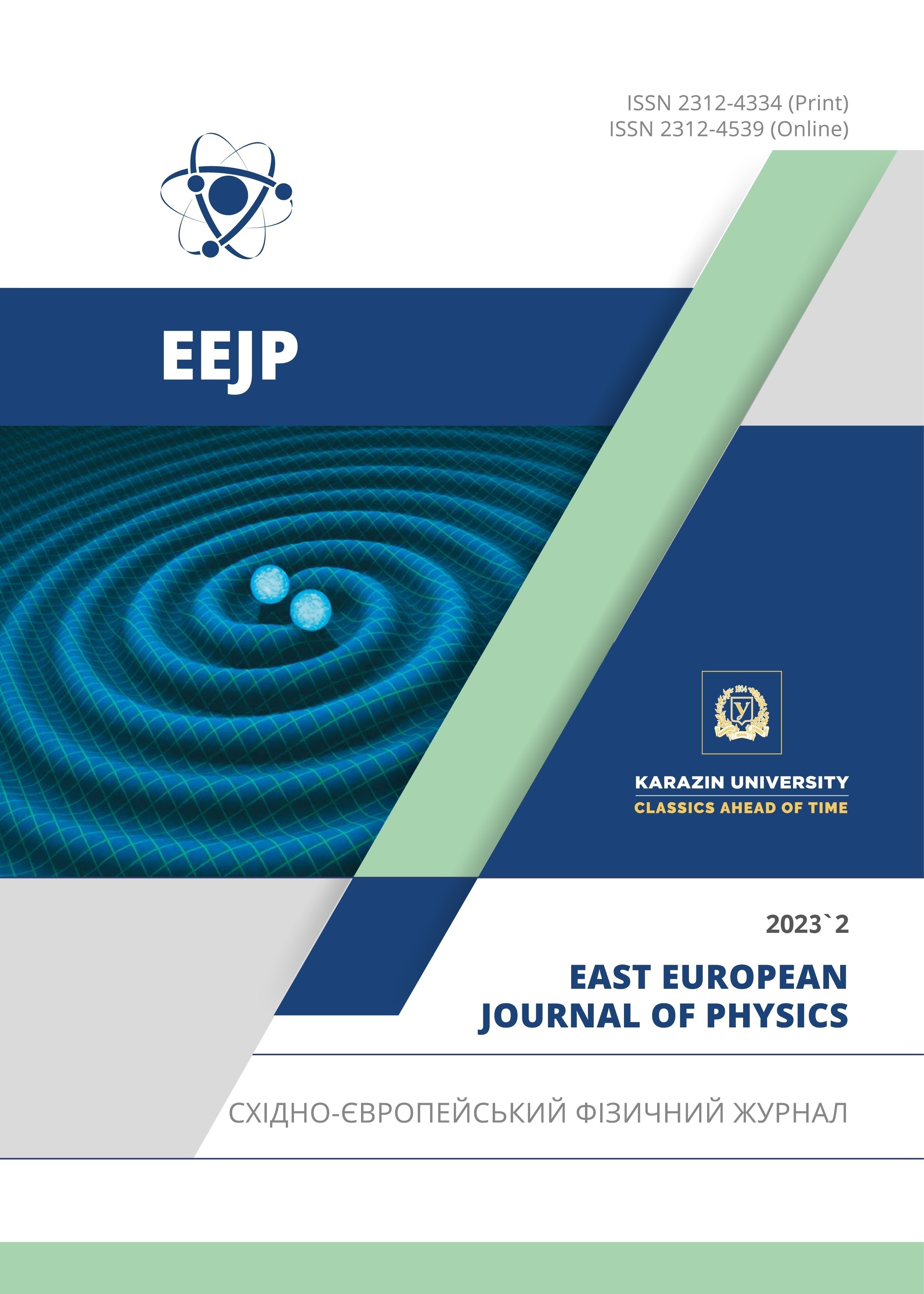Опис структури ядра германію (_32^66)Ge_34 з використанням ядерних моделей IBM-1, GVMI та VMI
Анотація
У цій статті для розрахунку рівнів енергії позитивної парності та її гамма-переходів як функція кутового моменту парно-парного (_32^66Ge_34) ядра використовувалися модель взаємодіючих бозонів (IBM-1), модель змінного моменту інерції (VMI) і узагальненого моменту інерції (GVMI). Також були оцінені співвідношення рівнів енергій (E_4^+)⁄(E_2^+ ), (E_6^+)⁄(E_2^+), and (E_8^+)⁄(E_2^+) та порівняні з експериментальними значеннями енергії та ідеальною схемою для трьох динамічних симетрій SU(5), SU(3) та O(6), щоб визначити динамічну симетрію цього ядра поточне дослідження показало, що при динамічна симетрія визначення O(6)-SU(5). Перетин енергетичної зони та явище вигину назад також вивчали за допомогою моделей (VMI) та (GVMI). Ці наслідки порівнювали з експериментальними результатами, і отримані результати добре узгоджувалися.
Завантаження
Посилання
University press, NewYork, P. 1-264 (1988).
[2] Abbas S. A., Salman S. H., Ebrahiem S. A., Tawfeek H. M, ''Investigation of the Nuclear
Structure of Some Ni and Zn Isotopes with Skyrme-Hartree-Fock Interaction'', Baghdad Science
Journal, Vol. 19, P. 914-921 (2022).
[3] Arima A. and Iachello F., "Interacting Boson Model", Ed., Iachello F., Pub. University of
Cambridge, England, P. 3-236 (1987).
[4] Arima, A. and Iachello F., "Boson Symmetries in Vibrational nuclei", Phys. Lett. B, Vol. 53,
P. 309-312 (1974).
[5] Otsuka T., Arima A. and Iachello F., "Shell model description of interacting bosons", Phys. Lett.
B, Vol. 76, P. 139-143 (1978).
[6] Kassim Y. Y., Al-Jubbori M. A., Ahmed I. M., Abdullah H. Y., and Sharrad F. I., "Microscopic
description of 170Er, 172Yb, 174Hf, 176W isotones", IOP Conf. Ser. Mater. Sci. Eng., Vol. 928,
P. 1-7 (2020).
[7] Scharf-Goldhaber G., Dover C. B., Goodman A. I., "The Variable Moment of Inertia (VMI)
Model and Theories of Nuclear Collective Motion", Annu. Rev. Nucl. Sci.,Vol. 26 P. 239-317
(1976).
[8] Mariscotti M.A.J., Scharf-Goldhaber G. and Buck B., "Phenomenological Analysis of Ground-
State Bands in Even-Even Nuclei", Phys. Rev., Vol. 178, P. 1864-1887 (1969).
[9] Bonatsos D.and Klein A., "Generalized phenomenological models of the yrast band", Phys.
Rev. C, Vol. 29, P.1879-1886 (1984).
[10] Arima A. and Iachello F., "The interacting boson model", Ann. Phys. (N.Y), Vol. 21, P. 75-105
(1981).
[11] Iachello F., "Algebraic approach to nuclear structure", Nucl. Phys. A, Vol. 369, P. 233-243
(1983).
[12] Krane, K. S.," Introductory Nuclear Phys.", John Wiley and Sons (1988).
[13] Arima A. and Iachello F., "Interacting boson model of collective states I. The vibrational
limit", Ann. Phys., Vol. 99, P. 253-317 (1976).
[14] Arima A. and Iachello F., " Interacting boson model of collective nuclear states II. The
rotational limit", Ann. Phys., Vol. 111, P. 201-238 (1978) .
[15] Arima A. and Iachello F., "Interacting boson model of collective nuclear states IV. The
O(6) limit", Ann. Phys.,Vol. 123, P. 468-492 (1979) .
[16] Khalaf A. M., Okasha M.D., Ahmed G.S.M., Abdelsalam A., "Identical bands in doubly even
nuclei in framework of variable moment of inertia (VMI) and interacting boson models", Nucl.
Phys. A, P. 1-16, Vol. 997,(2020).
[17] Venkova T. S. and Andreit Scheff W.," Transition strengths B(E2) in the yrast bands of doubly
even nuclei", Atomic data and nuclear data tables, Vol. 26, P. 93-136 (1981).
[18] Nojarov R. and Nodjakov E., "Band Coupling and Crossing in Nuclei", Nucl. Phys. A,
Vol. 397, P. 29 (1983).
[19] Holmberg P., "Calculation of rotational states in deformed nuclei", Neutron capture-Gamma ray
spectroscopy, P.463-467 (1969).
[20] Johnson A., Ryde H. and Sztarkier J., "Evidence for a “singularity” in the nuclear rotational
band structure", phys. Let. B, Vol. 34, P. 605-608 (1971).
[21] Ward D., Graham R.L.,Geijer J.S. and Androws H.R., "Anomalous Moments of Inertia for
High-spin Levels in The Beta Vibration Band of ", Phys. Lett. B,Vol. 44, P. 39-40 (1973).
[22] Birbrair B.L., "Influence of the nuclear Meissner - effect on the ground - state rotational bands
of deformed nuclei", phys. Let. B ,Vol. 39, P. 489-491 (1972).
[23] W. Greiner and J. A. Maruhn, "Nuclear Models", Springer Berlin Heidelberg, (1996).
[24] Sakai M., "Quasi-Bands in Even-Even Nuclei", Atomic data and nuclear data tables, Vol. 31, P.
399-432 (1984).
[25] Murray R., Spiegel and Larry J. Stephens," schaum's outlines statistics", Ed. Mc Graw Hill
(1999).
[26] E. Browne and J. K. Tuli, "Nuclear Data Sheet for A= 66", Vol. 111, P. 1093-1209 (2010).
[27] Casten R.F., and Warner D.D, "The interaction boson approximation", Rev. Mod. Phys., Vol.
60, P. 389-469 (1988).
Авторське право (c) 2023 Імад А. Хамді, Алі К. Аобейд

Цю роботу ліцензовано за Міжнародня ліцензія Creative Commons Attribution 4.0.
Автори, які публікуються у цьому журналі, погоджуються з наступними умовами:
- Автори залишають за собою право на авторство своєї роботи та передають журналу право першої публікації цієї роботи на умовах ліцензії Creative Commons Attribution License, котра дозволяє іншим особам вільно розповсюджувати опубліковану роботу з обов'язковим посиланням на авторів оригінальної роботи та першу публікацію роботи у цьому журналі.
- Автори мають право укладати самостійні додаткові угоди щодо неексклюзивного розповсюдження роботи у тому вигляді, в якому вона була опублікована цим журналом (наприклад, розміщувати роботу в електронному сховищі установи або публікувати у складі монографії), за умови збереження посилання на першу публікацію роботи у цьому журналі.
- Політика журналу дозволяє і заохочує розміщення авторами в мережі Інтернет (наприклад, у сховищах установ або на особистих веб-сайтах) рукопису роботи, як до подання цього рукопису до редакції, так і під час його редакційного опрацювання, оскільки це сприяє виникненню продуктивної наукової дискусії та позитивно позначається на оперативності та динаміці цитування опублікованої роботи (див. The Effect of Open Access).








